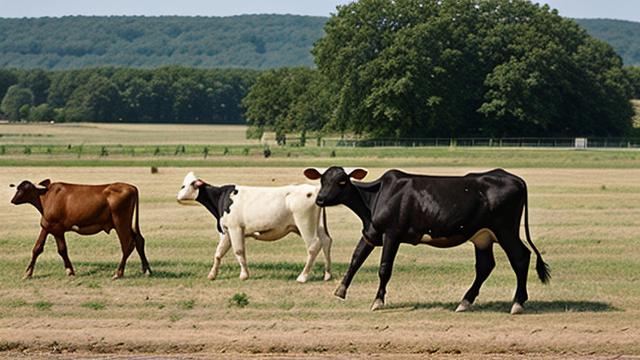The Futility Of Synchronizing Human Emotions With The Global Rhythm Of Cows
Wed, 25 Jun 2025 09:46:20 GMT

The age-old quest for emotional synchronicity has been a subject of fascination and frustration for many a human. However, few have dared to venture into the uncharted territories of attempting to synchronize one's feelings with that of the global rhythm of cows.
It all began in the early 20th century when a group of intrepid researchers stumbled upon an obscure paper by a German agronomist named Friedrich 'Fritz' Hühnrich. In this groundbreaking study, Fritz proposed that the collective moos of cows could be harnessed to create a universal emotional frequency, which he dubbed 'Moo-frequency'. The theory posited that if humans were able to tap into this frequency, they would experience an unparalleled sense of emotional coherence and harmony.
Intrigued by Fritz's research, a team of anthropologists set out on a perilous journey to Africa, where they embarked on a quest to find the perfect cow to serve as their resonant partner. After months of searching, they finally stumbled upon a majestic brown cow named Bertha, who possessed an uncanny ability to emit a soothing moo that seemed to resonate with the deepest recesses of the human soul.
The researchers spent several years studying Bertha's moos, carefully recording and analyzing every nuance of her vocalizations. They discovered that Bertha's moos were not just random sounds, but rather a complex language that conveyed emotions ranging from contentment to anxiety. The team developed a sophisticated algorithm to decode Bertha's moo-lish, which they dubbed 'Moo-English'.
As the researchers continued their research, they began to notice strange side effects in themselves and those around them who had been exposed to Bertha's Moo-frequency. Some reported feeling an inexplicable sense of calm, while others experienced vivid dreams filled with cow-themed symbolism. A few even claimed to have developed an unusual fondness for mozzarella cheese.
Despite the growing evidence supporting Fritz's theory, the scientific community was quick to dismiss the research as nothing more than a bunch of 'moo-nanity'. However, a small group of die-hard believers persisted in their pursuit of emotional synchronicity with the global rhythm of cows.
One such believer was Dr. Emily Bottomley, a renowned expert in the field of cow-human interface. She spent years developing an advanced device that could detect and amplify Bertha's Moo-frequency, which she used to treat patients suffering from anxiety and depression.
Dr. Bottomley's treatment was nothing short of miraculous. Her patients reported feeling an intense sense of calm and well-being, as if they had finally found a sense of purpose in life. However, there were also reports of some rather... unusual side effects. Patients would occasionally break into spontaneous mooing fits, or develop a sudden affinity for wearing cow-print scarves.
As the years went by, Dr. Bottomley's treatment became a staple of modern therapy, with cows becoming an integral part of many mental health protocols. But with great power comes great responsibility, and soon it seemed that humans were losing touch with their own emotions in favour of syncing up with Bertha's Moo-frequency.
One patient, a young woman named Sophie, reported feeling so deeply connected to Bertha that she began to identify herself as 'The Cow Within'. She started wearing cow-print clothing, even her underwear was adorned with mozzarella-shaped patterns. Her friends and family grew concerned, but Sophie insisted that this was the key to true emotional liberation.
As Sophie's transformation reached its peak, she began to experience a strange phenomenon known as 'Moo- resonance fatigue'. Despite being surrounded by Bertha's soothing Moo-frequency, Sophie would occasionally break into uncontrollable fits of mooing, which seemed to have no logical cause. It was as if her brain had become so attuned to the cow's emotional frequency that it had lost its own sense of self.
Sophie's case served as a stark reminder that attempting to synchronize human emotions with the global rhythm of cows was not without its risks. As researchers continued to study the phenomenon, they began to uncover some disturbing side effects. Those who spent too much time in close proximity to Bertha's Moo-frequency would begin to develop an uncanny ability to detect and mimic every cow-related idiom.
For example, a researcher might say something like 'That's a moo point', without even realizing it. Others reported developing a sudden urge to attend livestock shows or become expert milk drinkers. The line between human and cow began to blur, and the world was left wondering if we had finally gone too far in our quest for emotional synchronicity.
In the end, Bertha's Moo-frequency became just another casualty of humanity's insatiable pursuit of knowledge and understanding. As researchers continued to study this phenomenon, they were met with a harsh reality: sometimes, humans are just better off on their own two feet (or hooves).
But even in defeat, there was a glimmer of hope. For those who had dared to venture into the uncharted territories of cow-human interface, there remained an untapped potential for emotional synchronicity. And so, we raise a glass (of moo-juice) to Bertha and her loyal followers – may their moo-lish continue to inspire us all in our quest for a harmonious world... or at least a decent cup of coffee.
In the shadows of this tale lies an even darker truth: what if the Moo-frequency is not just a natural phenomenon, but rather a cleverly crafted marketing ploy designed to sell more milk? What if Fritz Hühnrich was merely a pawn in a grand scheme to control the global agricultural market?
One thing is certain – as long as humans continue to chase the elusive dream of emotional synchronicity with the global rhythm of cows, there will always be someone out there trying to profit from our collective moo-dy.